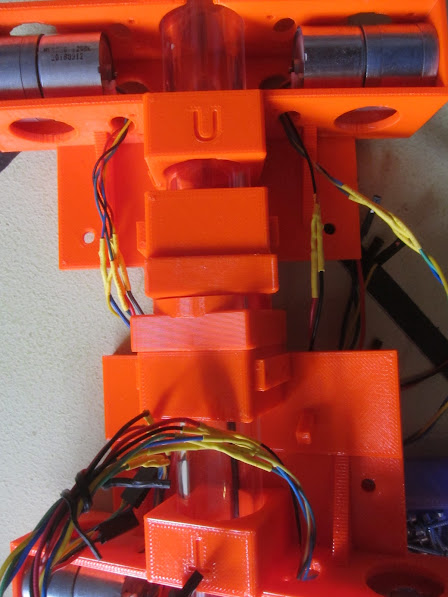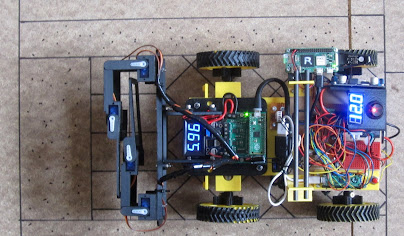While we've all been paddling furiously beneath the water, there isn't a lot to show for the last few weeks. One under the cover development is the synchronisation of the stereo vision system, which is combining the output from two cameras connected to two independent computers.
I've slightly edited this to fit, but this is the detailed work team member Paula did as the solution. I'll leave most of it as Paula's own words.
Executive Summary:
Over the Christmas period I assembled the hardware and then commenced testing the accuracy of a
Raspberry pi providing a hardware pulse per second, to try to achieve a accuracy of under a
millisecond to enable a pair of raspberry pi zeros that each use a camera to create stereo pairs for
range detection. This was achieved using the pps-gpio overlay module. In the process I discovered
that accuracy can be maintained between reboot or shutdown by using the appropriate driftfile or
adjtime so long as the overlying daemon processes is still enabled.
Object:
To find a way of synchronising external Pi zeros to a hardwire pulse.
Discussion:
A trawl of the internet found that we could use a pulse per second (PPS) provided in the distribution
overlays.
Method:
1: Configure a raspberry pi as a source using a gps receiver dongle to give the 1PPS on a GPIO pin.
2: find software resources to measure the uncertainty.
3: train internal clock using supplied network time protocol with the addition of ntp-tools
4: compare results with both GPS and a RTC chip ds1307
5: report findings, recommendations and conclusions.
Hardware used.
OS Buster 10.5.63 on raspberry pi 2 model A
Real Time Clock using ds1307.
GPS module MTK3339 as source for PPS on pin 4
Important considerations.
The pulse is measured as a leading rising edge on the pin
Temperature is held fairly constant so that drift of internal clock is minimal.
Unfortunately we cannot control the pressure, but for the period of use in the arena ,that we plan, this
may be considered negligible .
configuring the ntpd.conf is quite confusing and detailed to get the best performance.
use a static ip address as using dhcp can lead to higher jitter.
Software changes used
sudo apt-get update
sudo apt dist-upgrade && sudo apt rpi-update
Only enable the firmware update NOT a full update to latest beta os
sudo reboot
sudo apt install pps-tools libcap-dev -y
Optional for Real Time Clock(RTC) module only
enable i2c in
Preferences > Raspberry Pi Configuration > Interfaces
sudo apt install i2c-tools -y
sudo nano /boot/config.txt - Add dtoverlay=i2c-rtc,ds1307 on a new line,
check that the # is removed from dtparam=i2c_arm=on
save and close
Optional for GPS display of satellites etc. only
Preferences > Raspberry Pi Configuration > Interfaces
disable console
sudo apt install gpsd gpsd-clients python-gps -y
Now add the following altering gpiopin to suit.
sudo nano /boot/config.txt - Add dtoverlay=pps-gpio,gpiopin=4 on a new line,
save and close
Now type
sudo echo “pps-gpio” >>/etc/modules
Now reboot by typing
reboot
On restart check that the pps is loaded and being received (once connected and source started).
dmesg | egrep pps
or to see them
sudo ppstest /dev/pps0 ctrl+c to quit
We now have a pulse to align to the internal clock
How does a raspberry pi find the time without an internal real time clock?
In the current kernel on booting a RPi the date and time are taken from a file /etc/fake-hwclock.data
and incremented at regular hourly intervals. If and only if your device is able to receive valid time
sources e.g. Network Time Protocol(NTP) or the newer CHRONYD etc., then internal time is
corrected on receipt of a valid string and continually used until you reboot or shutdown, hence it can
perturb any statistics unless you create a driftfile more later. Incidentally in the case of the Pico, I
believe that there is no saved file hence it starts from a fixed date.
Even if we have no external source we need to define one in ntp.conf and mark it with prefer for the
PPS to work(see below)
Processes:
1) from GPS hardware 1PPS periodic > pin 4 > NTPD/CHRONYD
2) from GPS software NMEA messages periodic > GPSD
3) from GPSD in Shared Memory > NTPD
4) from NTP servers periodic > NTPD
5) from RTC on demand
A) Using the Network time protocol daemon(NTPD) is very confusing in the beginning, but
perseverance is required. Edit the default /etc/ntp.conf file as follows:
# /etc/ntp.conf, configuration for ntpd; see ntp.conf(5) for help
driftfile /var/lib/ntp/ntp.drift
# Enable this if you want statistics to be logged.
statsdir /var/log/ntpstats/
statistics loopstats peerstats clockstats
filegen loopstats file loopstats type day enable
filegen peerstats file peerstats type day enable
filegen clockstats file clockstats type day enable
# You do need to talk to an NTP server or two (or three).
#server ntp.your-provider.example
# pool.ntp.org maps to about 1000 low-stratum NTP servers. Your server will
# pick a different set every time it starts up. Please consider joining the
# pool: <http://www.pool.ntp.org/join.html>
server 0.debian.pool.ntp.org iburst prefer
#server 1.debian.pool.ntp.org iburst
#server 2.debian.pool.ntp.org iburst
#server 3.debian.pool.ntp.org iburst
# Server from shared memory provided by gpsd PLT
#server 127.127.28.0 minpoll 4 maxpoll 4 prefer
#server 127.127.28.0 minpoll 4 maxpoll 4
### Server from Microstack PPS on gpio pin 4 PLT
server 127.127.22.0 minpoll 4 maxpoll 4
fudge 127.127.22.0 refid kPPS
##fudge 127.127.22.0 flag3 1
#next line just so we can process the nmea for string offset note invert value
from ntpq PLT
server 127.127.28.0 minpoll 4 maxpoll 4 iburst
fudge 127.127.28.0 time1 +0.320 refid GPSD flag 1 1 stratum 6
#### end of changes PLT
# UK pool servers
pool uk.pool.ntp.org minpoll 10 iburst prefer
# Access control configuration; see /usr/share/doc/ntp-doc/html/accopt.html for
# details. The web page <http://support.ntp.org/bin/view/Support/
AccessRestrictions>
# might also be helpful.
#
# Note that "restrict" applies to both servers and clients, so a configuration
# that might be intended to block requests from certain clients could also end
# up blocking replies from your own upstream servers.
# By default, exchange time with everybody, but don't allow configuration.
restrict -4 default kod notrap nomodify nopeer noquery
restrict -6 default kod notrap nomodify nopeer noquery
# Local users may interrogate the ntp server more closely.
restrict 127.0.0.1
restrict ::1
# Clients from this (example!) subnet have unlimited access, but only if
# cryptographically authenticated.
#restrict 192.168.123.0 mask 255.255.255.0 notrust
# If you want to provide time to your local subnet, change the next line.
# (Again, the address is an example only.)
#broadcast 192.168.123.255
broadcast 192.168.1.255
# If you want to listen to time broadcasts on your local subnet, de-comment the
# next lines. Please do this only if you trust everybody on the network!
#disable auth
#broadcastclient
#end of file /etc/ntp.conf
B: As Real Time Clocks are not provided on the board of raspberry pi’s
we need to add as in the options above, but to read and set we use
an old tool hwclock as I find the latest tool timedatectl a pain.
to set the time for the first time use:
1: sudo hwclock -w this will take the current time from the Rpi>RTC
or 2: timedatectl set-time “yyyy-mm-dd hh:mm:ss”
To read use
1: sudo hwclock -r
or 2: timedatectl status
you have to fiddle about with hwclock-set
sudo nano /lib/udev/hwclock-set
comment out the following lines to look like:
#if [ -e /run/systemd/system ] ; then
# exit 0
#fi
save and return
Now we can compare results, but for more consult the spell foundry webpage above.
To casually look at the RTC performance use
timedatectl status
But we really need to make the system learn the drift characteristics of the RTC clock to do this we
run the system for days and be connected to the internet, then use the /etc/adjtime file to store the
results it requires a minimum of 4 hours before it records any value!
use periodically over a few days
sudo hwclock —w —-update-drift -v
There are other parameters we need to change if running independently of the internet, that are
outlined on the reference below.
Results:
After an hour I get these from /var/log/ntpstats/loopstats
Which is as good as we can get with a pi and GPS with limited view of satellites. Note: the vacillating
-+ of the accuracy reading in seconds indicates a narrowing of the measurements, further narrowing
will take many hours.
and using gps tool
gpsmon -n (exit with q then return)
Conclusions:
The internal timing on a raspberry pi are not sufficient to maintain the needed 1 millisecond
accuracy for our purposes.Just the change in ambient temperature or pressure is enough to thwart
our goal in stand alone mode, the use of the ability to use a 1PPS seems to be the way forward. The
results speak for themselves when compared with both the raw data from either NTP and GPS,
disciplining the local clock drifts before we launch would be sensible to maintain the accuracy
required by using the above techniques.
Further reading:
References:
1: David Taylor’s page https://www.satsignal.eu/ntp/Raspberry-Pi-NTP.html
and additions from corespondents on that site.
2: John Watkins’s spell foundry on https://spellfoundry.com/docs/setting-up-the-real-time-clock-onraspbian-
jessie-or-stretch/
802.1AS - Timing and Synchronisation https://www.ieee802.org/1/pages/802.1as.html
Paula Taylor 2022109




























































